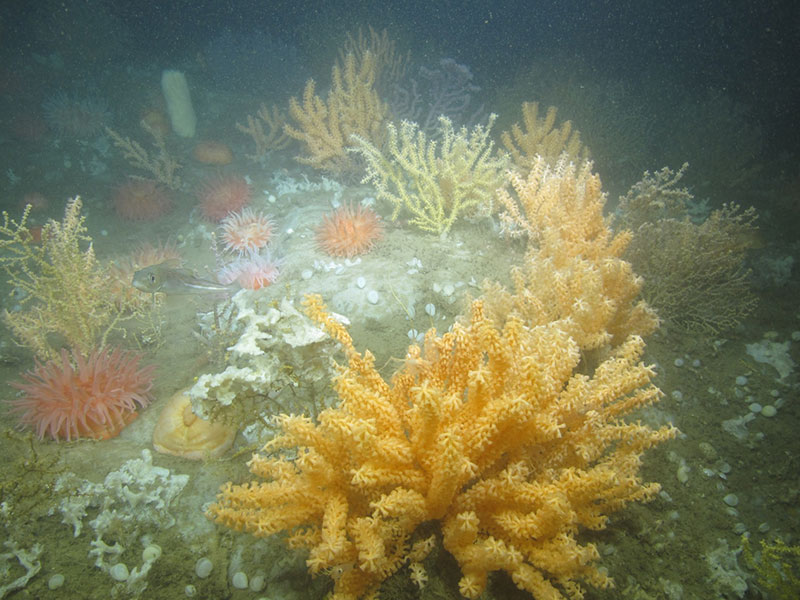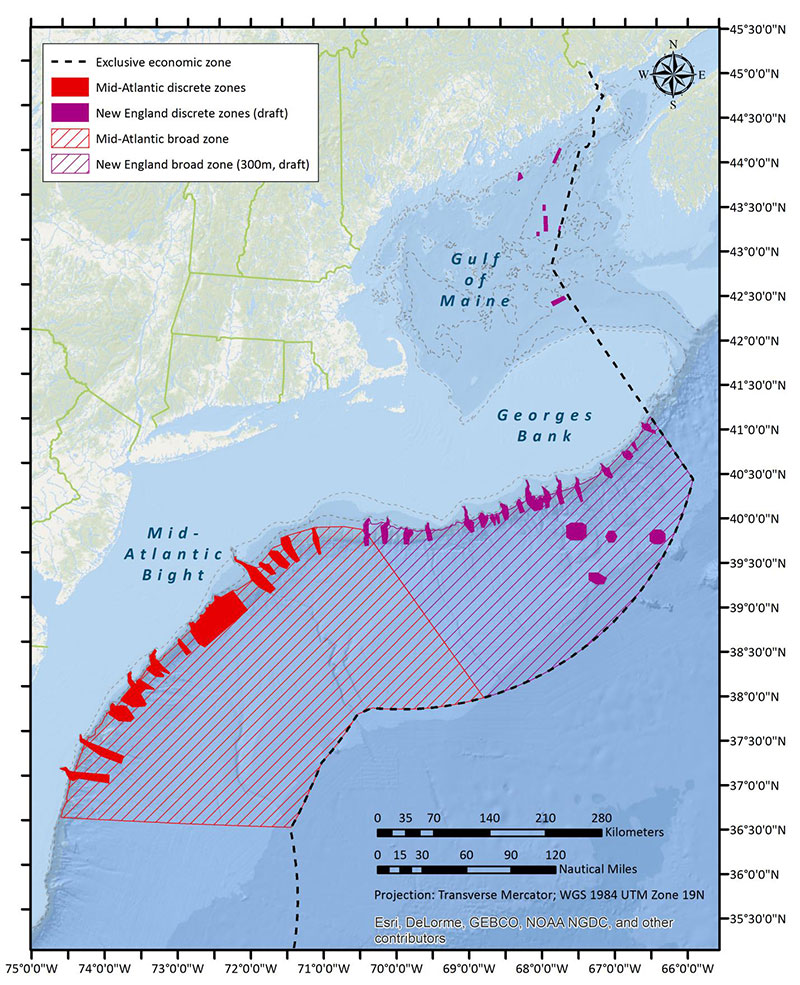
by Dave Packer, National Marine Fisheries Service, Northeast Fisheries Science Center, James J. Howard Lab

An example of deep-sea coral garden habitat in Western Jordan Basin, Gulf of Maine. This area would be protected under the current New England Fisheries Management Council proposal. Image courtesy of NMFS NEFSC/UConn – NURTEC/UMaine. Download larger version (jpg, 1.0 MB).
The 2007 Magnuson-Stevens Fishery Conservation and Management Act provides a mechanism by which to protect deep-sea corals in U.S. waters. Fisheries in federal waters are primarily managed by NOAA’s National Marine Fisheries Service (NMFS) under fishery management plans developed by the various regional Fishery Management Councils. Under the Magnuson-Stevens Act, regional councils are given the authority to designate deep-sea coral protection zones and implement measures to protect corals from the impacts of bottom fishing gear, including trawls, dredges, bottom longlines, and traps. Two fishery management councils operate in the Northeast region: the New England and Mid-Atlantic Fishery Management Councils (NEFMC and MAFMC).

Deep-sea coral protection zones in the Northeast region designated by the Mid-Atlantic Fisheries Management Council and proposed by the New England Fisheries Management Council. Alvin Canyon straddles the New England/Mid-Atlantic inter-council boundary. New England Council zone boundaries will likely change as the management process is finalized. Image courtesy of Michelle S. Bachman, New England Fishery Management Council. Download larger version (jpg, 1.1 MB).
Some major deep-sea coral conservation actions have recently occurred off the northeastern United States. In 2015, the MAFMC exercised their discretionary authority to protect deep-sea corals. The council recommended specific proposals to NMFS to prohibit the use of most types of bottom fishing gear in an area of ocean bottom from New York to Virginia.
The proposed management zones extended from the outer continental shelf starting at depths of about 450 meters (1,476 feet) and included the continental slope and submarine canyons out to the 200-mile U.S. boundary limit. This recommendation was approved by NOAA in 2016, marking the first use by a regional Council of the Magnuson-Stevens Act’s authority to designate deep-sea coral protection zones.
The protected area, officially designated as the “Frank R. Lautenberg Deep-Sea Coral Protection Area,” covers approximately 98,420 square kilometers (38,000 square miles) of seafloor. The area, larger than Maryland, New Jersey, and Delaware combined, is the largest such protected area in the entire U.S. Atlantic. Senator Lautenberg (D-NJ), was responsible for, and authored, several important pieces of ocean conservation legislation, including the deep-sea coral protection provisions in the 2007 Magnuson-Stevens Act.
In 2016, off New England, President Obama designated the Northeast Canyons and Seamounts Marine National Monument, the first national monument in the Atlantic. The Monument, covering an area of more than 12,690 square kilometers (4,900 square miles), is located about 210 kilometers (130 miles) east-southeast of Cape Cod, and protects, among other things, critical deep-sea coral habitat. The monument covers two distinct areas: three submarine canyons (Oceanographer, Gilbert, Lydonia) and four seamounts (or “mountains in the sea” named Bear, Physalia, Retriever, and Mytilus).
Also off New England, the NEFMC is developing and evaluating management options for protecting deep-sea corals in their region. The NEFMC could make final recommendations to NOAA this year. The NEFMC has taken a similar approach to that of the MAFMC, considering areas from the heads of the deep submarine canyons and adjacent areas of the continental slope out to the 200-mile limit. Additionally, some small, shallower (around 200 meters or 650 feet) deep-sea coral gardens within the northern Gulf of Maine (Central and Western Jordan Basin, near Mount Desert Rock, on Outer Schoodic Ridge, and on Lindenkohl Knoll in Georges Basin) are also being considered.
Data collected during this cruise will provide additional contemporary information to the NEFMC. Information we collect will be assessed, analyzed, and considered during their decision-making process. Thus, the NEFMC’s final recommendations on coral alternatives will be based on the best available science.